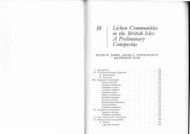Create successful ePaper yourself
Turn your PDF publications into a flip-book with our unique Google optimized e-Paper software.
anitroph., Char. Chrysotrichetalia chlor. – borsmed(-med-mo)<br />
– r.rare; Sch, Vog, Pf, RhSch,<br />
ThW, v.rare O, Rhön<br />
LIT.: LAUNDON 1981, TONSBERG 1992.<br />
Cladonia Hill ex Browne<br />
(Determination incl. Pycnothelia)<br />
Introduction<br />
The species <strong>of</strong> the genus Cladonia are usually<br />
moderately conspicuous fruticose lichens.<br />
Numbered with them are the well known reindeer<br />
and cup lichens. The Cladonia plant consists, as<br />
a rule, <strong>of</strong> two parts, that spreading over the<br />
substrate “ground based,” squamulose or small<br />
foliose thallus and the more or less erect<br />
growing, higher podetia, whose many forms are<br />
known: horn- or peg-form, strongly bushy<br />
branching, trumpet- or coral-like. On the podetia<br />
develop brown, deep red or rarely yellowish<br />
apothecia without thalloid margin. Often no<br />
apothecia are produced; reproduction then occurs<br />
by thallus fragments or soredia, with which the<br />
upper surface <strong>of</strong> the may be entirely or partially<br />
covered. In the case <strong>of</strong> the richly branching,<br />
almost never fruiting reindeer lichens, the basic<br />
thallus is extremely reduced.<br />
Many species are very variable. The species<br />
concept is in many cases not stable. They are<br />
frequently separated into several chemical races,<br />
sometimes even hybrid intermediate forms. The<br />
world wide distributed genus numbers perhaps<br />
350 species. In the Federal Republic <strong>of</strong> Germany<br />
are – according to species understanding – ca. 60<br />
to 67 species recorded, in <strong>Baden</strong>-<strong>Württemberg</strong><br />
54 to 62.<br />
The Cladonia species live on naked soil, raw<br />
humus, moss, decaying wood, rarely bark and<br />
weathered rock. They usually flourish under well<br />
lighted, humid conditions on acid soil, on sites,<br />
on which through great nutrient distress or soil<br />
surface features has inhibited the competition <strong>of</strong><br />
higher plants or the vegetation layer has not yet<br />
closed after disturbance. They are frequently<br />
found on appropriate sites, e.g. rocky clearings,<br />
numerous unrelated species, as e.g. C.<br />
rangiferina, C. arbuscula, C. protentosa, C.<br />
furcata, C. squamosa, C. gracilis, C. pysidata, C.<br />
pleurota, C. unicalis and others. Under more<br />
humid conditions reindeer lichens and other<br />
Cladonias may even compete in dwarf shrubby<br />
heath.<br />
On decaying wood – almost all also on raw<br />
humus and peat – live especially C. botrytes, C.<br />
cenotea, C. coniocraea, C. digitata, C. pysicata<br />
ssp. chlorephaea, C. macilenta, C. norvegica, C.<br />
parasitica (almost only on oak stumps), C.<br />
polydactyla and C .squamosa. C. incrassata<br />
over runs peat, especially on the walls <strong>of</strong> peatcutting.<br />
Calcareous soils are only typical for a few<br />
species, thus for C. furcata ssp. subrangiformis,<br />
c. rangiformis, C. convoluta, C. symphycarpa, C.<br />
pysicata ssp. pysicata and ssp. pocillum. They<br />
are found in dry turfs and rocky meadows.<br />
Most <strong>of</strong> the indigenous species are distributed<br />
in the central European region and in the boreal<br />
zone, and isolated up into the arctic. The area is<br />
partially stretched into the mediterranean region;<br />
to these very widely distributed species belong C.<br />
cariosa, C. cervicornis, C. cenotea, C.<br />
coniocraea, C. digitata, C. fimbriata, C. furcata,<br />
C. mitis, C. pysidata, C. squamosa, C. subulata<br />
and C. symphycarpa. Widely distributed in<br />
central and north Europe (mostly up into the<br />
arctic) are also C. arbuscula, C. cornuta, C.<br />
deformis, C. gracilis, C. phyllophora, C.<br />
pleurota, C. rangiferina, C. rei and C. unicalis;<br />
they penetrate however – <strong>of</strong>ten with the<br />
exception <strong>of</strong> the Pyrenees –scarcely toward south<br />
Europe. The area <strong>of</strong> C. amaurocraea, C.<br />
bellidiflora, C. botrytes, C. carneola, C.<br />
macrophylla, C. metacorallifera, C. stellaris and<br />
C. sulphurina stretches over the boreal zone and<br />
frequently up into the arctic; in central Europe<br />
these species occur only as disjuncts penetrating<br />
the mountains. In the region they live on<br />
overhanging rocks <strong>of</strong> the high places, cold<br />
boulder fields and peat moors. The central<br />
European habitat lies mostly in the Böhmerwald,<br />
in Fichtel- and Erzgebirge, in the Sudentes, in<br />
Harz, in the Vosges, in the Black Forest and in<br />
the Alps.<br />
Many Cladonias reach the northern boundary<br />
in southern Sweden and Finland, penetrating<br />
however near the sea in western Scandinavia<br />
further toward the north. In the south stretching<br />
the distribution area usually to the submediterranean<br />
or partially, as e.g. in the case <strong>of</strong><br />
C. ciliata and C. rangiformis, into the<br />
mediterranean region. This group includes C.<br />
caespitica, C. ciliata, C. portentosa, C. foliacea,<br />
C. ramulosa, C. rangiformis, C. rei and C. zopfii.<br />
Many <strong>of</strong> these species show westward<br />
163





